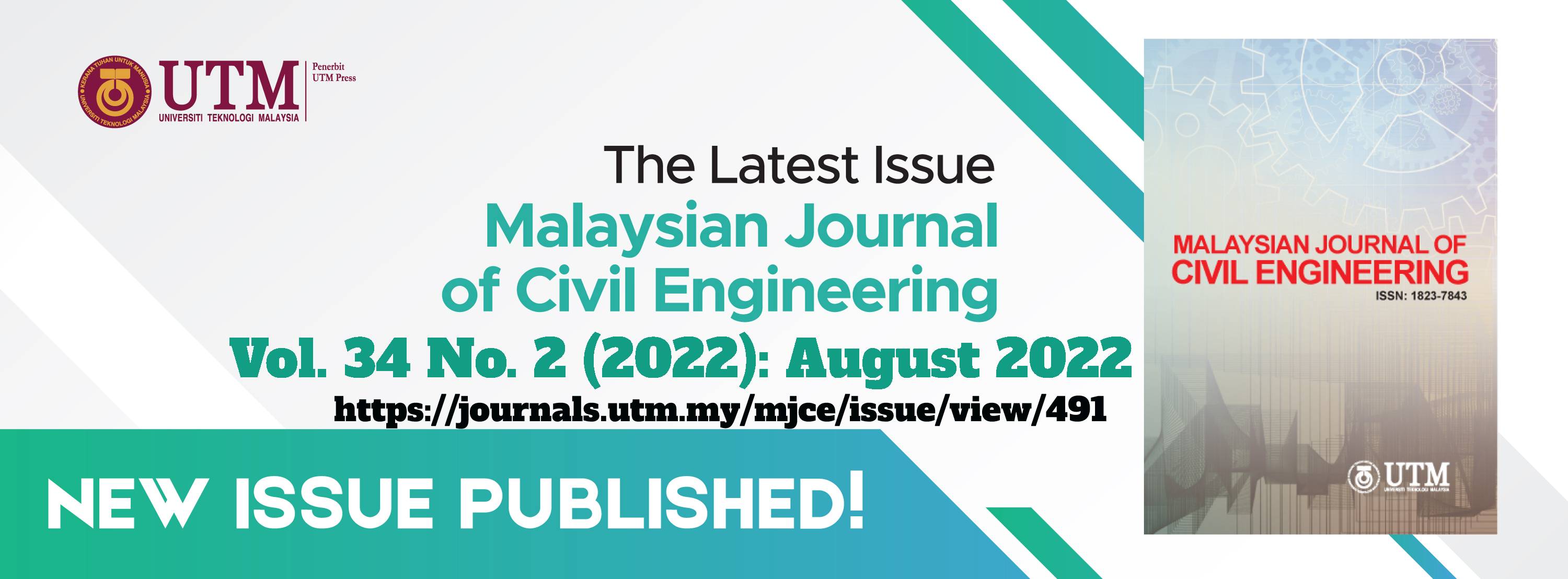APPLICATION OF HYDE SEISMIC PROTECTION SYSTEM IN MEDIUM RISE RC BUILDINGS WITH SOFT STOREY IN BANGLADESH
DOI:
https://doi.org/10.11113/mjce.v34.18372Keywords:
Seismic protection, passive control, Hysteretic Device, structural control, soft storey seismic controlAbstract
Bangladesh has a long history of earthquakes and the largest one that occurred here is of 8.7 magnitudes Great Indian Earthquake. Several international researchers showed the possibility of large earthquake to occur in this area in near future, which will cause damages of infrastructures resulting in loss of human lives. It has been observed that most of the existing medium rise reinforced concrete (RC) buildings in the urban areas of Bangladesh have soft ground floor which have been designed without following proper seismic design code, hence do not full fill the demand strength required against an earthquake. These existing medium rise RC buildings with soft ground floor need to be retrofitted with a suitable technique. In this study the performance of Hysteretic Device (HYDE) system in a medium rise RC building selected from an urban area of Bangladesh is checked by SAP 2000v15 software. HYDE is a passive control system especially developed for soft storey seismic control of medium rise building structure. A nonlinear time history analysis is performed using three earthquake data developed from normalized acceleration response spectra to check the performance of HYDE. From the analysis, design HYDE force is achieved as 6300 kN. It has been observed from the generated HYDE curve that, the overall horizontal displacement against the seismic force is reduced from 0.176 m. to 0.035 m. Which means, by the application of HYDE system, 80% of displacement can be reduced.
References
Ahmed M., Ansary M.A., Chowdhury M.A.I., Ahmed M.S., Rahman M. 2005. Probable Building Damage by Earthquake in Sylhet City. Bangladesh Journal of Environmental Science, 11(1): 50-57.
BNBC 2020. Bangladesh National Building Code. Housing and Building Research Institute, Mirpur, Dhaka, Bangladesh.
Bolt B.A. 1987. Seismic and Seismic Intensity for the Region North of the Conference of the Jamuna and Ganges River, Submitted Jamuna Multipurpose Bridge Authority, Government of People’s Republic of Bangladesh. 1-7.
CDMP 2009. Comprehensive Disaster Management Program. Earthquake Vulnerability Assessment of Dhaka, Chittagong and Sylhet City Corporation Area. Ministry of Disaster Management and Relief, Bangladesh.
CSI Analysis reference manual for SAP2000, ETABS and SAFE 2009.
Dorka U. E. 1994. Hysteretic device Systems for Earthquake Protection of Buildings. Proceedings of the Fifth US National Conference on Earthquake Engineering, Chicago, Illinois, July 10-14.
Dorka U. E. and Gleim S. 2006. HYDE Systems for Earthquake Protection of Residential Buildings. Advances in Earthquake Engineering for Urban Risk Reduction, 195-208.
Gleim S. and Dorka U. E. 2008. A Design Method for Hysteretic Device System. 14th World Conference on Earthquake Engineering, 12th to 17th October.
Idrizi I. S., Dorka U. E., Idrizi Z. S. 2012. Application of HYDE Structural Control System for RC Buildings. 15th World Conference on Earthquake Engineering, Lisboa.
Mazzolani Federico M. 2000. Moment Resistant Connections of Steel Frames in Seismic Areas. Tylor and Francis Group.
Potty N.S. and Sirajuddin M. 2011. Assessment Of Building For Seismic Resistance, Malaysian Journal of Civil Engineering 23 (1).
Schmidt K. and Dorka U. E. 2004. Experimental Verification of HYDE System. 13th World Conference on Earthquake Engineering, 1st to 6th August, Vancouver, B.C., Canada.
Tahmmed M. Al-Hussain, Tahsin R. Hussain, M Naeem Al Noman. 2012. Proposed Changes to The Geotechnical Earthquake Engineering Provisions of The Bangladesh National Building Code. Geotechnical SEAGS and AGSSEA. 43(02): 1-7. June 2012 ISSN 0046- 5828..
Tesfamariam S. and Saatcioglu M. 2010. Seismic Vulnerability Assessment of Reinforced Concrete Buildings Using Hierarchical Fuzzy Rule Based Modeling. Earthquake Spectra 26 (1): 235-256.
Torunbalci N. 2004. Seismic Isolation and Energy Dissipating Systems in Earthquake Resistant Design. 13th World Conference on Earthquake Engineering, 1st to 6th August, Vancouver, B.C., Canada.
Wenk T. (2008). Seismic Retrofitting of Structures. Strategies And Collection of Examples in Switzerland. Environmental studies No. 0832. Federal Office for the Environment, Bern. 84
Wen Y. K.(1980. Equivalent Linearization for Hysteretic System Under Random Excitation. Journal of Applied Mechanics. 47(1): 150-154.
















